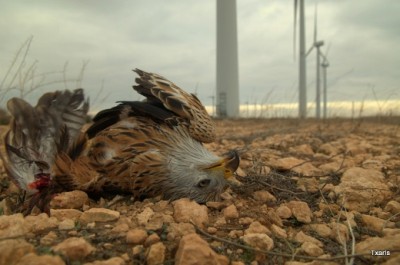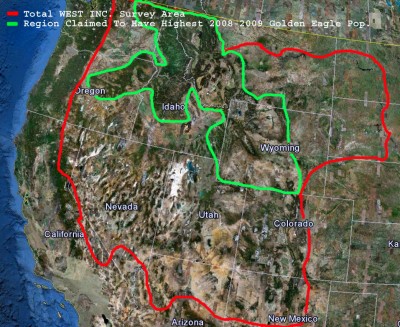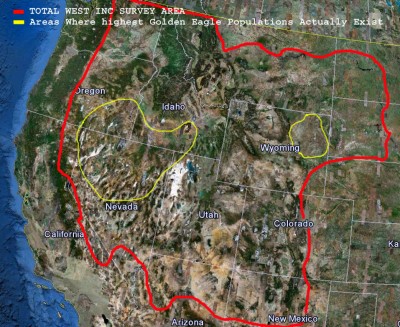| Wind Watch is a registered educational charity, founded in 2005. |
Golden eagles fall prey to wind industry
Credit: By Jim Wiegand, wildlife biologist, April 17, 2010 (San Diego’s East County) eastcountymagazine.org ~~
Translate: FROM English | TO English
Translate: FROM English | TO English
The controversy surrounding wind farms in America has been brewing for over 25 years. The debate centers around the use of the deadly propeller style wind turbines and the large death toll to what are supposedly protected species. One of these species, the federally protected golden eagle, has been at the forefront of this debate from the beginning.
This is for good reason, because at Altamont Pass California, 50-75 golden eagles have been killed each year in the blades of the prop wind turbine. This killing has been taking place for over 25 years. Dr. Shawn Smallwood the foremost expert of bird mortality at the Altamont Pass wind farm estimates that 2300 golden eagles have been killed by the spinning turbine blades.
Along with the golden eagle, many thousands of other birds of prey have been slaughtered there as well from this source of green energy.
As far as wind farms go, the history of Altamont pass is not an exception, it just happens to be the most scrutinized wind farm in the world. A cloak of secrecy now envelopes most other American wind farms.
Despite this slaughter of raptors, corporate heads have been steamrolling ahead with wind farm expansion. Hundreds of thousands of prop wind turbines are now planned for America. One of the biggest regions for the harvest of wind energy is planned for the Western United States. Today Planning Departments all over the west are being faced with the choice of having wind power in their communities. In order to obtain the proper permits, Federal and State laws require an analysis of the environmental impacts so communities can make the right choice.
My research into the wind industry has uncovered a very disturbing trend in their method of disclosing environmental impacts. What I have found is that the wind Industry in American routinely uses false or incomplete Environmental Impact Reports (EIRs) to white-wash the detrimental impacts of the prop wind turbine. For the wind industry, environmental analysis basically comes down to disclosing as few impacts as possible to an ignorant audience. The biological assessments are either paid by the industry for or created from wind industry influence in political arena. These grossly incompetent documents are produced solely to manipulate and expedite the permitting process for wind farm approval.
In an effort to keep ahead of the critics and to help persuade planning departments, many worthless studies have been launched on behalf of the wind industry. Currently there is an ongoing group of these studies under the direction of the U.S. Fish and Wildlife Service that needs to be exposed. These studies, if not stopped will be used to influence the public and planning departments for many years to come.
Since 2003 a golden eagle survey has been taking place in the Western U.S. Each year at a cost of hundreds of thousands of dollars to American taxpayers, Western EcoSystems Technology, Inc (West, Inc) has been paid to conduct a yearly population survey from an airplane. Each year a plane filled with observers crisscrosses a 757,883 sq mile region of the West in search of Golden Eagles. The surveys are called Population Level Survey of Golden Eagles in the Western United States or Survey of Golden Eagles in the Western United States.
I first became familiar with the work of West, Inc when this Wyoming based company conducted the biological studies for the Hatchet Ridge Wind project in Shasta County, CA. These studies for this project were conducted by West Inc. over a 1 year period.
In their substandard environmental impact analysis presented to Shasta County, 11 species of birds of prey that face death from this prop wind turbine project were left out of their documents. One is the endangered great grey owl and the other is the most common raptor in the region during the fall and winter months, the rough-legged hawk.
I know this because I studied the wildlife in this region 18 years.
The public and planning departments in need to take note because the golden eagle survey conducted by West Inc is also a mockery.
Since these surveys began in 2003 the West Inc survey teams have only documented 155-222 golden eagles in any given year from their airplane seats. From these numbers they have then extrapolated their meager sightings into yearly population estimates ranging from of 27,392 in 2003 to 20,722 golden eagles in 2009. As a result the true population estimates have been exaggerated many times over and this false information is now being disseminated.
As I will point out, there are some very good reasons to discard these surveys.
It does not matter how skilled the observer, the fact is that identification of the golden eagle and determining age class is not easy. It is a well documented fact that the golden eagle is very often confused with immature bald eagles. With the West Inc observers flying around in an airplane I can imagine there being a lot of confusion between the two because it appears that results of these yearly surveys have to be contaminated with immature bald eagle sightings counted as golden eagles.
Mistakenly identifying golden eagles is common. I even witnessed this with UC Berkeley staff on college on field trips.
These surveys have been broken up into four geographic regions. One is called the Northern mountain region of the Western U.S. This is the area of the survey overlaps that overlaps primary bald eagle Western habitat (see image). Over the last two years the West Inc. survey reports the most golden eagles in this area even though this region represents only secondary golden eagle habitat. Much of the habitat in this region of the survey cannot even support a population of golden eagles because of the abundance of cover and lack of prey species. This area has also been under drought conditions for years. This further affects the available food supply for the golden eagle.
Yet if we are to believe the estimates put out by West Inc for entire 193,000 sq. mile region of what they classify as Northern Mountain habitat, there is a golden eagle every 25 sq. miles. In actuality there is not even one golden eagle every 200 sq. miles for this region.
In the past I conducted my own golden eagle research. This intermountain habitat had an elevation ranging between 3000-5000 feet. The habitat included juniper woodland, forest, semi desert, and grasslands. I found that this habitat will support a nesting pair of nesting golden eagles in about a 100 sq. mile territory under the best of conditions. I observed one pair that actually hunted over a 200 sq. mile territory during the spring and summer months exploiting pockets in the habitat where their preferred prey lived.
Over the last 40 years there have been intense ground and air surveys of some of the very best golden eagle habitat that exists in the Western US. These are habitats in Northern Nevada, Northwestern Utah, the Snake River drainage of Idaho, and the Thunder Basin area of Wyoming. These are areas that support large populations of either rabbits, ground squirrels or prairie dogs. These are the pockets of habitat that can actually support an eagle every 25 sq. miles.
When considering just these prime pockets of golden eagle habitat and include all the surrounding lesser habitat in their respective counties, the golden eagle populations still only come out to about one pair of nesting golden eagles every 80-100 sq. miles in less than 10% of the counties of the 13 western states surveyed. None of these counties exist in the Northern Mountain Habitat region of the survey.
The Thunder Basin National Grassland was surveyed in 2006 by the USDA and they only reported 18 golden eagle nests for the entire 893 sq. mile National Park. This works out to one eagle nest for every 49.6 sq. miles in this prime habitat. In 2003 the West Inc survey of the 757,883 sq. miles region of the Western U.S. reported a total golden eagle population of an astounding 27,392 eagles. This figure represents one eagle existing for every 27 sq. miles of every bit of the western habitat. These reported figures are ridiculous.
In Southern Nevada, Arizona, New Mexico, the Rocky Mountains there are vast areas of poor habitat included in the survey where there is not even one pair of eagles every 400-500 sq. miles. There are also 1000’s of sq. miles of cities, towns, farms and industrial areas no eagle habitat exists. This too must be factored in to any population estimates.
I have provided a map to show where the highest year round populations and densities golden eagles actually exist in the Western U.S.
The proportion and number of juvenile golden eagles in the reported in surveys are also erroneous. I say this because when identifying young juvenile golden eagles one must keep in mind that they look nearly identical to those birds that have not completed their first molt. This would make the juvenile eagles counted in the survey are actually a mix of two different years of golden eagle offspring. Thus the actual fledged or juvenile golden eagles reported by the West Inc are actually lower than those stated in the surveys. Photographs are the best way to tell them apart and to document what is really an eagle recently fledged from the nest vs. an eagle from the previous year.
When considering the amount of juvenile eagles accounted for in this series of surveys, I will now point out the most damming or contradictory fact of the West Inc golden eagle surveys. The age classes of the given eagle population in the surveys contradict their own total population conclusions. This further invalidates the survey results. The West Inc surveys state a population that is made up of approximately 12,000 adult golden eagles. These adults are reported to be producing fewer than 2000 young each of the last 4 years.
In reality a population of 12,000 adult eagles would easily produce 5000-6000 offspring for each of these years. It is well documented from decades of research that nesting Golden Eagles on average produce between .75 and 1.25 fledged young per year. Even if we were to accept the inflated 2000 number of juveniles given in the survey, it would indicate a population of half the size given.
As I have pointed out in this report, there are not nearly as many golden eagles as reported in the West Inc surveys. The population of golden eagles in the 13 western states has been exaggerated 3-4 times.

Eagles aren’t the only birds falling prey to razor-sharp turbine blades. In Italy, red kites brought back from the brink of extinction have been decimated by wind turbines, experts report.
SUMMARY
I find it ironic that these extensive surveys were contracted out to private industry even though under the employment of the USFWS there are many qualified people that could conduct a much more accurate analysis of the golden eagle. Many biologists who are currently under the employment of the USFWS, USDA, and State wildlife departments that will agree with this report. Unfortunately they must answer to the policies dictated by industry and remain silent.
I believe there is a clear wind industry motive and political influence behind the production of these surveys. After all the more eagles reported means that there will appear to be a less detrimental impact to the population from the introduction of wind turbines into their habitats. Also the fewer the reported environmental impacts, the less there is to mitigate for the wind industry.
It is also my understanding that these surveys are planned for 20 years. That’s just about long enough to get to get the planned 150,000- 200,000 turbines and the needed transmission lines installed into this region of the Western U.S.
So if this gauntlet of turbines is installed and the golden eagle population is found to be in a nose dive…. Then what? Who will be responsible? Not the wind industry because they will be protected by the “no surprises clause” conveniently written into the Federal law pertaining to incidental take permits.
The golden eagle population in the West will decline rapidly because number of the propeller style wind turbines being introduced into their Western habitat. Accurate numbers are critical in order for every Planning Department to understand the cumulative impacts. The eagles destined to be killed in the future will number in the thousands. These numbers will not only include victims from the nesting population in the Western U.S. but also those migrating from Canada and Alaska.
Inflating the Golden Eagle population with imaginary statistics typifies many of the problems that plague our society. Today virtually any expert can be bought or silenced out of fear of retribution. We all see it, and many of us have been touched by this corruption. A common example is the use of false documentation by insurance companies. Today falsified reports are routine and bogus testimony from insurance friendly Doctors can be expected in nearly every legal case.
This situation is nearly the same with the wind industry with one notable exception, where are the official opposing views to offset the wind industry’s bias to planning departments. It is a major flaw in our system and until it is fixed none of the major environmental problems of this era will be fixed.
This report represents the true state of the golden eagle population and it should be circulated to every in planning department in the Western U.S. I have been paid nothing to write this and have been influenced by no one.
List of Federal Golden Eagle Survey Contracts given to West Inc
http://www.fedspending.org/fpds/devel/fpds.php?parent_id=372197&sortp=u&detail=3&datype=T&reptype=r&database=fpds&fiscal_year=2003&submit=GO
http://www.fedspending.org/fpds/devel/fpds.php?parent_id=372197&sortp=u&detail=3&datype=T&reptype=r&database=fpds&fiscal_year=2006&submit=GO
http://www.fedspending.org/fpds/devel/fpds.php?parent_id=372197&sortp=u&detail=3&datype=T&reptype=r&database=fpds&fiscal_year=2007&submit=GO
http://www.fedspending.org/fpds/devel/fpds.php?parent_id=372197&sortp=u&detail=3&datype=T&reptype=r&database=fpds&fiscal_year=2008&submit=GO
Jim Wiegand is an independent wildlife biologist with a degree from the University of California, Berkeley.
This article is the work of the source indicated. Any opinions expressed in it are not necessarily those of National Wind Watch.
The copyright of this article resides with the author or publisher indicated. As part of its noncommercial educational effort to present the environmental, social, scientific, and economic issues of large-scale wind power development to a global audience seeking such information, National Wind Watch endeavors to observe “fair use” as provided for in section 107 of U.S. Copyright Law and similar “fair dealing” provisions of the copyright laws of other nations. Send requests to excerpt, general inquiries, and comments via e-mail.
| Wind Watch relies entirely on User Funding |
 (via Stripe) |
 (via Paypal) |
Share:
| Tag: Birds |



